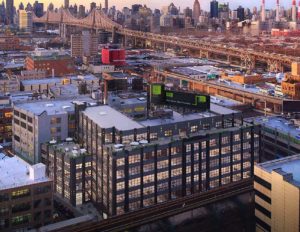Work Begins on Life Science Conversion in NYC
Completion is expected in the second quarter of 2023.

43-10 23rd St. Image courtesy of Suffolk Construction
The repurposing of a 218,000-square-foot office building in Long Island City, N.Y., into a life science facility dubbed Hatch Life Sciences is underway. Suffolk Construction is in charge of the property’s gut renovation and redevelopment. Completion is expected in the second quarter of 2023, according to The LIC Post.
Longfellow Real Estate Partners, together with Sculptor Real Estate, purchased a majority stake in the property in 2021 for $92.5 million, according to CommercialEdge data, with plans to invest an additional $120 million into the building’s conversion to lab use. A $155 million loan from Square Mile Capital Management financed the transaction.
The project’s debut comes amid the rejuvenation of New York City’s life science sector. The city has received the $1 billion LifeSci NYC investment that translated into more than 1 million square feet of space under construction in the first quarter of 2022, according to a Colliers report.
“New York City has the highest level of life sciences educational attainment—with nearly 2.5 million residents holding degrees in science, engineering and engineering-related fields. But the city is being held by from fully realizing its potential as a major player in the life science industry by a lack of available space that can accommodate companies at every stage of their existence—from start-up to manufacturing. This project will help bridge that gap and ensure the city is maximizing its considerable investment into the life science sector,” a spokesperson from Suffolk told Commercial Property Executive.
READ ALSO: Why the Life Sciences Boom Is Not Likely to Bust
Initially constructed as an industrial building in 1924 and used as office space, the future home of Hatch Life Sciences rises seven stories at 43-10 23rd St. When complete, the facility will feature research and laboratory space across flexible open floorplans. The building is within 1 mile of the Queensboro Bridge, providing quick access to Manhattan’s research universities and hospitals.
Life science real estate adapts and evolves
The property’s redevelopment takes place as the nation’s life science sector adapts to a time of demand far exceeding supply. Much of this bottlenecking is attributable to the many cities with emerging markets possessing limited land availability, while the projects themselves have specific and costly building requirements.
Many developers and life science companies, particularly those located in cities where demand is the highest, have taken to purchasing and renovating existing property, as opposed to building new facilities from the ground-up. One such example is bio-technology company TARGAN’s transformation of a Raleigh, N.C., Kroger grocery store into a manufacturing and laboratory space.







You must be logged in to post a comment.